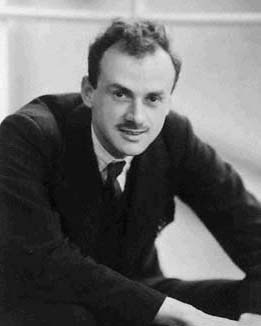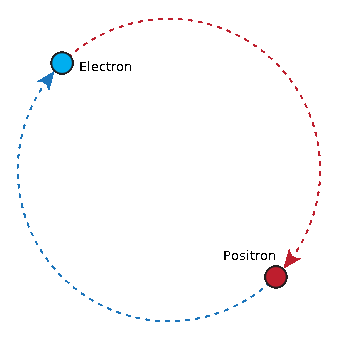"Anti" Gravity
February 8, 2012
CPT was the brand name of one of the first commercial
word processing systems. These were sold by the company, Cassette Powered Typewriting, which began by offering cassette data storage systems for the
IBM Selectric Typewriter. When these were first introduced into our offices in the early 1980s, CPT meant something altogether different to me. CPT is
physicist's shorthand for a
combined symmetry involving
charge and
parity inversion and
time reversal.
Everything seems to obey CPT, although there is evidence that
antimatter might behave differently. A principal argument that antimatter is not symmetrical with ordinary matter is that our
universe seems to be composed entirely of ordinary matter, for no apparent reason. That's reason enough for physicists to investigate how closely antiparticles match their ordinary matter counterparts.
One major problem with experiments to study the complementarity between the matter and antimatter worlds is that antimatter combines with normal matter to produce
photons in a mutual annihilation. This very efficient
mass-energy conversion is what fuels the
antimatter drive on many
fictional spacecraft.
Gravitation measurements are the most difficult measurements to make, since gravity is such a weak force, and it's usually masked by stronger
electromagnetic forces. The repulsive electrical force between two
electrons is nearly 10
43 times stronger than their gravitational attraction. In a
previous article (What Falls Up, June 10, 2008), I wrote about the planning stage of the
AEGIS experiment at
CERN. AEGIS, short for "Antimatter Experiment: Gravity, Interferometry, Spectroscopy," is designed to produce
antihydrogen atoms, made as a combination of
antiprotons and
positrons, and measure their
gravitational acceleration. Antihydrogen atoms are neutral, so electromagnetic forces are not an issue.

I went to high school with two girls named Pam.
Here's a PAM of a different sort. Paul Adrien Maurice Dirac, who validated the idea of antimatter in a 1928 paper.
(Cambridge University, Cavendish Laboratory, photograph, circa 1930, via Wikimedia Commons))
The idea of AEGIS is to measure the small vertical deflection of an antihydrogen beam. Since the particles would be traveling at a few hundred
meters per second, the deflection over a
meter's travel would be just a few
micrometers. A
Moiré deflectometer would detect such a small change. The
Moiré pattern is obtained by sending the antihydrogen beam through a series of
diffraction gratings.[1]
How important is this
experiment? It's not even known whether antiparticles may possess
antigravity, which would be really interesting.[2] Many experiments in search of a "
fifth force" may have ruled this out. These so-called
Eötvös experiments, named after their originator,
Loránd Eötvös, look for differences between the
inertial mass and
gravitational mass of objects, so they're a test of the
equivalence principle. The objects studied would have a different number of
virtual antimatter particles, and the study results do not indicate any anomalous forces.[3]
An important part of such an experiment is the creation of a sufficient quantity of antihydrogen that's stable for an extended period.
Scientists took the first step in November, 2010, when they were able to confine 38 atoms of antihydrogen for 172 milliseconds.[6-7] They followed up with a report in June, 2012, of the capture of 309 antihydrogen atoms for up to 1,000 seconds.[NP] Importantly, these atoms were contained long enough for many of them to reach their
ground state, a necessary condition for an accurate measurement in the planned experiment.[6]
The containment field, which held these atoms and prevented them from contacting the walls of the containment vessel and annihilating themselves, was an array of eight
magnetic poles. You can probably call this a double
quadrupole. Although the atoms are neutral, they are affected by a magnetic field because of their small
magnetic moment. The antihydrogen is made in the trap when antiprotons entering it are combined with positrons. This type of trap will only work if the antiprotons entering it are moving very slowly. In
temperature terms, they are at about 0.5
kelvin.[6]
The AEGIS approach is the most direct method of ascertaining the gravitational properties of antimatter, but its not the only method.
Positronium is another neutral combination of particles, although it's an
exotic atom composed of an electron and a positron in orbit about each other (Yes, this is the classical picture. The
quantum reality is quite different).

An "atom" of positronium.
Positronium is composed of an electron and a positron in orbit about each other. It usually has a very short lifetime, but it exists longer when in an excited state.
(Image by Harry Mustoe-Playfair, via Wikimedia Commons))
Physicists
David Cassidy,
Allen Mills and
Harry Tom of the
Department of Physics and Astronomy,
University of California (Riverside, California), along with graduate student Tomu H. Hisakado, have been generating excited states of positronium known as
Rydberg positronium.[9] The excitation is done by
incoherent laser excitation to
principal quantum numbers up to 25.[8]
In these Rydberg states, the electron and positron are very weakly bound, so the exotic atom's lifetime is longer by a factor of 10-100.[9] That's still not long enough for meaningful experiments of gravitational force using
free fall, so the UC team is trying to add additional
angular momentum to the ensemble to boost lifetime by a factor of 100,000. This would give a positronium lifetime of about 10 milliseconds to allow a beam of these atoms a reasonable deflection under gravity.[9]
The University of California-Riverside team is working to complete this next task in their gravity experiment this summer.[9] Perhaps this team of four will get results before the considerable number of scientists on the AEGIS team. The University of California-Riverside research is supported by the
National Science Foundation and the
U.S. Air Force Research Office.[9]
References:
- G. Testera, A.S. Belov, G. Bonomi, I. Boscolo, N. Brambilla, R. S. Brusa, V.M. Byakov, L. Cabaret, C. Canali, C. Carraro, F. Castelli, S. Cialdi, M. de Combarieu, D. Comparat, G. Consolati, N. Djourelov, M. Doser, G. Drobychev, A. Dupasquier, D. Fabris, R. Ferragut, G. Ferrari, A. Fischer, A. Fontana, P. Forget, L. Formaro, M. Lunardon, A. Gervasini, M.G. Giammarchi, S.N. Gninenko, G. Gribakin, R. Heyne, S.D. Hogan, A. Kellerbauer, D. Krasnicky, V. Lagomarsino, G. Manuzio, S. Mariazzi, V.A. Matveev, F. Merkt, S. Moretto, C. Morhard, G. Nebbia, P. Nedelec, M.K. Oberthaler, P. Pari, V. Petracek, M. Prevedelli, I. Y. Al-Qaradawi, F. Quasso, O. Rohne, S. Pesente, A. Rotondi, S. Stapnes, D. Sillou, S.V. Stepanov, H. H. Stroke, G. Tino, A. Vairo, G. Viesti, H. Walters, U. Warring, S. Zavatarelli, et al., "Formation Of A Cold Antihydrogen Beam in AEGIS For Gravity Measurements," arXiv Preprint Server, May 30, 2008.
- Which way does antimatter fall? (Physics arXiv Blog, June 3, 2008).
- L. Bod, E. Fischbach, G. Marx And Maria Náray-Ziegler, "One Hundred Years Of The Eötvös Experiment," Hungarian Academy of Sciences Web Site, August 31, 1990.
- The ALPHA Collaboration, "Confinement of antihydrogen for 1,000 seconds," Nature Physics, vol. 7, no. 7 (June 5, 2011), pp. 558-564.
- Alexis Madrigal, "Scientists Create Antimatter They Can Actually Study," The Atlantic, June 5, 2011.
- Thomas H. Maugh II, "Capture of antimatter opens window on Big Bang," Los Angeles Times, June 5, 2011.
- Alok Jha, "Scientists trap antimatter long enough to study how it works," Guardian (UK), June 5, 2011.
- D. B. Cassidy, T. H. Hisakado, H. W. K. Tom and A. P. Mills, Jr., "Efficient Production of Rydberg Positronium," Phys. Rev. Lett., vol. 108, no. 4 (January 27, 2012), Document No. 043401.
- Iqbal Pittalwala, "Does Antimatter Weigh More Than Matter?" University of California-Riverside Press Release, January 26, 2012.
Permanent Link to this article
Linked Keywords: CPT Word Processor; word processing; IBM Selectric Typewriter; physicist; combined symmetry; CPT; charge; parity; time; antimatter; universe; photon; mass-energy conversion; antimatter drive; spacecraft in Star Trek; fictional spacecraft; gravitation; electromagnetic force; electron; AEGIS experiment; CERN; antihydrogen; antiproton; positron; gravitational acceleration; Paul Adrien Maurice Dirac; Wikimedia Commons; meters per second; meter; micrometer; Moiré deflectometer; Moiré pattern; diffraction grating; experiment; antigravity; fifth force; Eötvös experiment; Loránd Eötvös; inertial mass; gravitational mass; equivalence principle; virtual antimatter particle; scientist; ground state; magnetic pole; quadrupole; magnetic moment; temperature; kelvin; positronium; exotic atom; quantum mechanics; quantum reality; Harry Mustoe-Playfair; David Cassidy; Allen Mills; Harry Tom; Tomu H. Hisakado; Department of Physics and Astronomy; University of California (Riverside, California); Rydberg; incoherent; laser; principal quantum number; free fall; angular momentum; National Science Foundation; U.S. Air Force; Research Office.